

Infographics - Kathy Schrock's Guide to Everything. 6 Ways To Use Drag And Drop Interactions In Your eLearning Course. 5 branching elearning and branching scenario examples. When it comes to online learning experiences, branching can be a great way to help learners practice, keep things interesting and relevant, and improve retention.

Get ideas for how you could better engage your audience with these five branching examples. Branching simply means designing different routes through the content, depending on input from the user. Infographics - Kathy Schrock's Guide to Everything. Online Assignments: 10 Tips. "Designing Successful Online Assignments: 10 Tips" (pdf) provides practical guidance for and examples of each of the following suggestions: "Take it seriously.

""Communicate clear expectations. ""Design (small) successful experiences. ""Make the activity worthwhile. ""Offer choices. "" Online Assignments: 10 Tips. Making Online Peer Review Effective. "Finding the Instructional Value in Peer Review Discussion Boards" (article) offers steps to make the process more effective by modeling for students "how to participate and get the most out of peer review activities": "Just because students are asked to collaborate with each other, doesn’t mean there is no role for the instructor to play.
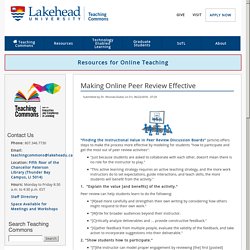
""This active learning strategy requires an active teaching strategy, and the more work instructors do to set expectations, guide interactions, and teach skills, the more students will benefit from the activity. " Peer Assessment 101. 1.
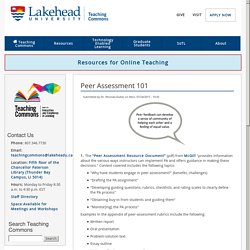
The "Peer Assessment Resource Document" (pdf) from McGill "provides information about the various ways instructors can implement PA and offers guidance in making these decisions. " Content covered includes the following topics: Design Thinking for Educators. Design thinking is a mindset. It is the confidence that everyone can be part of creating a more desirable future, and a process to take action when faced with a difficult challenge. That kind of optimism is well needed in education. Classrooms and schools across the world are facing design challenges every single day, from teacher feedback systems to daily schedules. Wherever they fall on the spectrum of scale – the challenges educators are confronted with are real, complex, and varied.
Videos - The K. Patricia Cross Academy. Empathy Maps: A Tool for Learning Experience Design.
Discussions. Gamification. Brain-based Techniques. Icebreakers. Project-Based Learning. Group Work. Addressing Learning Styles. Instructional Techniques and Resources for STEM. Rethinking Direct Instruction in Online Learning. Direct Instruction has a bad reputation.

It is often associated in higher education with long lectures and passive learners. “Passivity isn’t wrong because it’s boring; it’s wrong because it doesn’t work” (Daniel and Bizer, 2005, p. 103). Direct Instruction is an instructional model that consists of three main components: modeling, guided practice with formative feedback, and independent practice. When utilized correctly, the Direct Instruction model is anything but boring, and students should never be passive recipients of learning. Beyond the scope of a traditional classroom, there are ways to incorporate Direct Instruction in an online format. 1. Direct Instruction starts with the presentation of new material. 2.
The key element of this Direct Instruction phase is providing frequent feedback. 3. The final phase of Direct Instruction is independent practice. Direct Instruction should be an ongoing exchange between professor and students. Bocchi, J., Eastman, J. Park, C. Using PowerPoint Effectively in Your Courses - Faculty Focus. Although PowerPoint often gets a bad rap as an instructional tool, it really doesn’t deserve it.
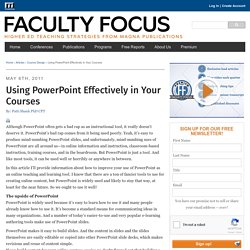
PowerPoint’s bad rap comes from it being used poorly. Yeah, it’s easy to produce mind-numbing PowerPoint slides, and unfortunately, mind-numbing uses of PowerPoint are all around us—in online information and instruction, classroom-based instruction, training courses, and in the boardroom. But PowerPoint is just a tool. Designing Effective Clicker Questions by Going Beyond Factual Recall - Faculty Focus. At one point, a General Chemistry course at Penn State Berks had a success rate of about 50 percent, giving the multi-section course the dubious distinction of having one of the lowest GPAs on campus.

After a thorough redesign, the course now consistently achieves a success rate of well over 70 percent, while the student ratings of the course and the instructors have never been higher. The key element in this chemistry course’s redesign? Clickers. As evidence of the importance of student engagement and active learning continues to grow, clickers have become a powerful tool for helping instructors adopt a more learner-centered teaching style.
Active learning activities. Using Role Play Simulations to Promote Active Learning. Role play simulation is a form of experiential learning that allows you to “cover” the same sort of topics as you would in a lecture course while moving your students from passive to active learners.
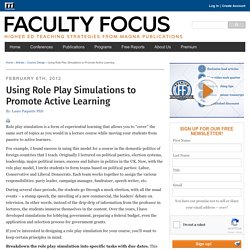
For example, I found success in using this model for a course in the domestic politics of foreign countries that I teach. Originally I lectured on political parties, election systems, leadership, major political issues, success and failure in politics in the UK. Now, with the role play model, I invite students to form teams based on political parties: Labor, Conservative and Liberal Democrats.
Each team works together to assign the various responsibilities: party leader, campaign manager, fundraiser, speech writer, etc. During several class periods, the students go through a mock election, with all the usual events – a stump speech, the unveiling of a new commercial, the leaders’ debate on television. Breakdown the role play simulation into specific tasks with due dates. Dr. Three Strategies for Creating Meaningful Learning Experiences.
Do you ever wonder whether your students care about your course material?
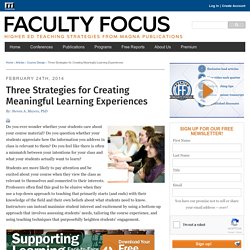
Do you question whether your students appreciate how the information you address in class is relevant to them? Do you feel like there is often a mismatch between your intentions for your class and what your students actually want to learn? Students are more likely to pay attention and be excited about your course when they view the class as relevant to themselves and connected to their interests.
Professors often find this goal to be elusive when they use a top-down approach to teaching that primarily starts (and ends) with their knowledge of the field and their own beliefs about what students need to know. The Names We Give to Our Instructional Strategies. Instructional strategies acquire names, labels that describe what the strategy involves—active learning, problem-based learning, cooperative learning.
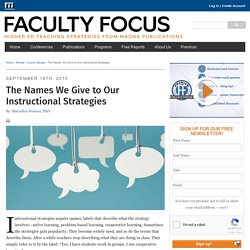
Sometimes the strategies gain popularity. They become widely used, and so do the terms that describe them. After a while teachers stop describing what they are doing in class. They simply refer to it by the label: “Yes, I have students work in groups. A Blog Assignment with Results - Faculty Focus. Blogging can be a tool that aids learning. “Blogs provide students with an opportunity to ‘learn by doing’ to make meaning through interaction with the online environment.” (p. 398) They provide learning experiences described as “discursive,” meaning students learn by discussing, which makes blogs a vehicle for knowledge construction. They exemplify active learning and can promote higher-order thinking. Potential outcomes like these give teachers strong incentives to explore their use. Teaching and Assessment Strategies. Taking practice-based and literature-informed approaches, the CTL partners with Queen’s educators by providing expertise to enhance pedagogical practices, and provides educational leadership within the context of Canadian higher education.
Teaching for Active Learning Teaching for Active Learning Focus on Active Learning: Active Learning Strategies. 150 Teaching Methods. Lecture by teacher (and what else can you do!) Class discussion conducted by teacher (and what else!) Recitation oral questions by teacher answered orally by students (then what!) Discussion groups conducted by selected student chairpersons (yes, and what else!) Learning activities - University of Waterloo. Teaching and Learning with Lecture Capture. Diana Laufenberg: How to learn? From mistakes.